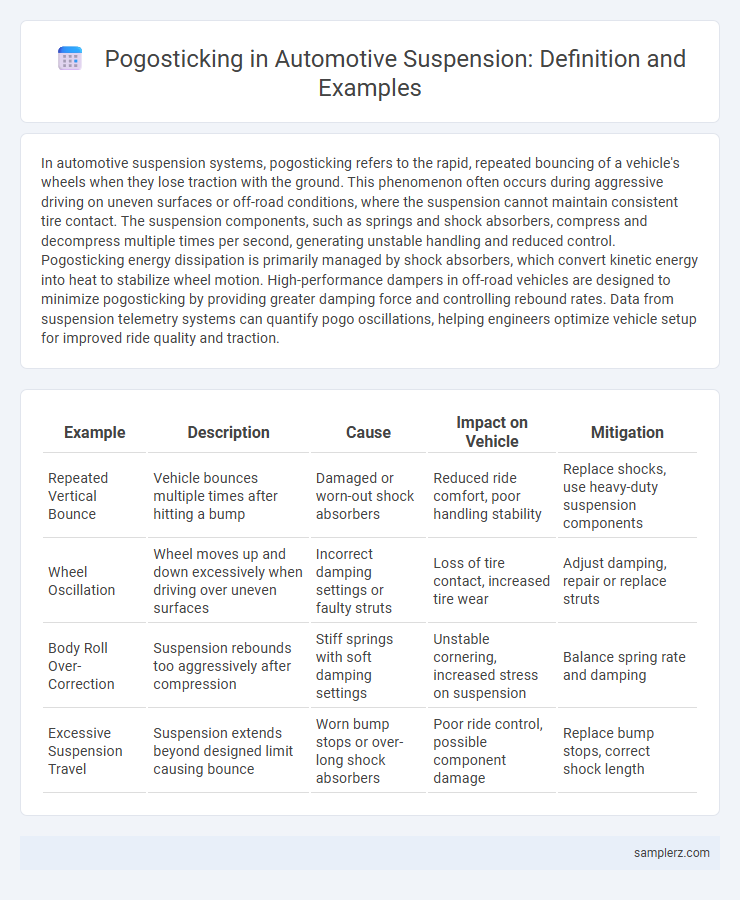In automotive suspension systems, pogosticking refers to the rapid, repeated bouncing of a vehicle's wheels when they lose traction with the ground. This phenomenon often occurs during aggressive driving on uneven surfaces or off-road conditions, where the suspension cannot maintain consistent tire contact. The suspension components, such as springs and shock absorbers, compress and decompress multiple times per second, generating unstable handling and reduced control. Pogosticking energy dissipation is primarily managed by shock absorbers, which convert kinetic energy into heat to stabilize wheel motion. High-performance dampers in off-road vehicles are designed to minimize pogosticking by providing greater damping force and controlling rebound rates. Data from suspension telemetry systems can quantify pogo oscillations, helping engineers optimize vehicle setup for improved ride quality and traction.
Table of Comparison
| Example | Description | Cause | Impact on Vehicle | Mitigation |
|---|---|---|---|---|
| Repeated Vertical Bounce | Vehicle bounces multiple times after hitting a bump | Damaged or worn-out shock absorbers | Reduced ride comfort, poor handling stability | Replace shocks, use heavy-duty suspension components |
| Wheel Oscillation | Wheel moves up and down excessively when driving over uneven surfaces | Incorrect damping settings or faulty struts | Loss of tire contact, increased tire wear | Adjust damping, repair or replace struts |
| Body Roll Over-Correction | Suspension rebounds too aggressively after compression | Stiff springs with soft damping settings | Unstable cornering, increased stress on suspension | Balance spring rate and damping |
| Excessive Suspension Travel | Suspension extends beyond designed limit causing bounce | Worn bump stops or over-long shock absorbers | Poor ride control, possible component damage | Replace bump stops, correct shock length |
Understanding Pogosticking in Automotive Suspensions
Pogosticking in automotive suspensions occurs when the vehicle's shock absorbers fail to adequately dampen the springs, causing a rapid series of oscillations after hitting a bump. This phenomenon leads to reduced tire contact with the road, diminishing traction and compromising vehicle stability and control. Understanding suspension components such as dampers, springs, and their interaction is crucial for diagnosing and preventing excessive pogosticking in vehicles.
Common Causes of Pogosticking in Vehicles
Pogosticking in vehicle suspension often results from worn or damaged shock absorbers that fail to dampen road impacts effectively. Bald or uneven tire wear reduces traction, amplifying the bouncing effect on uneven surfaces. Inadequate spring tension or broken coil springs also contribute to the rapid vertical oscillation characteristic of pogosticking.
Signs Your Suspension Is Pogosticking
Signs your suspension is pogosticking include excessive vertical bouncing after hitting bumps, decreased tire contact with the road, and a noticeable loss of vehicle control during rough terrain driving. You may also experience uneven tire wear, increased body roll, and a harsh, uncomfortable ride due to the suspension's inability to properly absorb shocks. Monitoring these indicators helps prevent further damage to suspension components and ensures safe vehicle handling.
Real-World Examples of Pogosticking Incidents
Pogosticking in automotive suspension occurs when a vehicle's shock absorbers fail to adequately dampen the springs, causing the car to bounce repeatedly over uneven road surfaces. Real-world examples include off-road vehicles encountering rocky terrain, where excessive vertical oscillations compromise stability and control. This phenomenon is frequently observed in older SUVs with worn-out shocks during harsh braking, leading to prolonged suspension bounce and reduced tire contact with the road.
How Pogosticking Affects Driving Safety
Pogosticking in automotive suspension occurs when excessive rebound causes the vehicle's tires to lose consistent contact with the road surface, reducing traction and control. This phenomenon increases the risk of skidding and instability during maneuvers, compromising braking efficiency and overall handling performance. Effective damping systems and properly tuned suspension components are essential to minimizing pogosticking and enhancing driving safety.
Diagnosing Suspension Pogosticking Problems
Pogosticking in automotive suspension occurs when the shock absorbers fail to dampen road impacts effectively, causing the vehicle to bounce excessively. Diagnosing suspension pogosticking problems involves inspecting shock absorber seals for leaks, checking for worn or damaged struts, and testing the rebound rate by pushing down on the vehicle's corners to observe the bounce response. Identifying issues such as fluid loss or internal damage in shocks ensures timely replacement or repair, restoring proper suspension performance and vehicle stability.
Differences Between Pogosticking and Other Suspension Issues
Pogosticking in automotive suspension occurs when the shocks fail to adequately control wheel movement, causing the vehicle to bounce uncontrollably over uneven surfaces. Unlike general suspension problems such as worn bushings or broken springs, pogosticking specifically results from shock absorbers losing damping efficiency, often detected by rapid, repeated vertical wheel oscillations. Identifying pogosticking requires analyzing shock absorber condition, whereas other suspension issues may stem from alignment, component wear, or structural damage.
Preventing Pogosticking in Modern Suspension Systems
Preventing pogosticking in modern suspension systems hinges on incorporating advanced damping technologies such as adaptive shock absorbers and electronically controlled suspension, which adjust stiffness in real time to maintain tire contact with the road. Utilizing high-quality gas-charged struts and twin-tube shocks enhances energy absorption, reducing rapid oscillations for improved vehicle stability. Regular maintenance, including inspecting bushings and replacing worn components, ensures optimal suspension performance and minimizes the risk of pogosticking during dynamic driving conditions.
Solutions for Fixing Pogosticking in Cars
Pogosticking in car suspension occurs when worn-out shocks or struts fail to dampen the motion, causing the vehicle to bounce excessively after hitting a bump. Replacing the worn shock absorbers with high-quality, OEM or aftermarket performance shocks can significantly restore ride stability and improve handling. Installing upgraded suspension components like polyurethane bushings and ensuring correct tire pressure further reduces pogo effects and enhances overall driving comfort.
Future Technologies to Eliminate Pogosticking
Emerging adaptive suspension systems utilize real-time sensor data and AI algorithms to predict and counteract pogosticking by dynamically adjusting damping rates. Magnetorheological (MR) dampers offer precise control over suspension stiffness, significantly reducing vertical oscillations on rough terrains. Integration of advanced machine learning models enhances vehicle stability by continuously optimizing suspension responses, paving the way for pogosticking elimination in future automotive designs.

example of pogosticking in suspension Infographic
 samplerz.com
samplerz.com